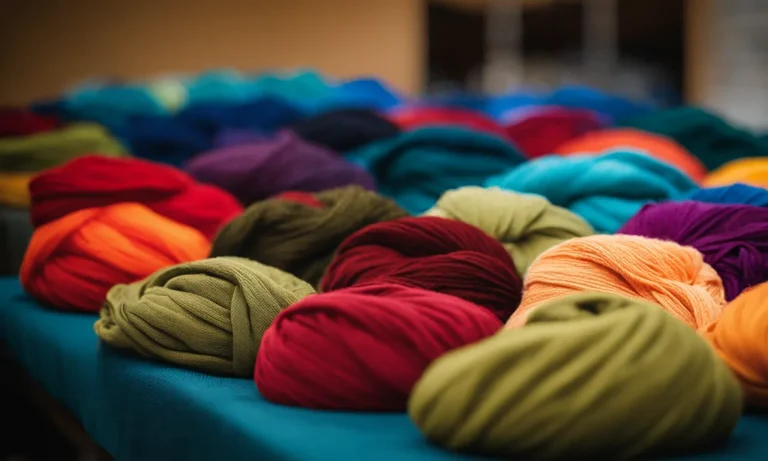What Is Nylon Fabric Made From? A Detailed Look At Nylon Production
Nylon fabric has become ubiquitous in our lives. From clothing to furniture upholstery, nylon is a versatile and durable synthetic fabric that has countless uses. But what exactly is nylon made from?
If you’re short on time, here’s a quick answer to your question: Nylon fabric is made from petroleum-based chemicals that are derived during the oil refining process. The basic substances used to create nylon are adipic acid and hexamethylene diamine.
In this comprehensive article, we’ll take an in-depth look at how nylon is produced from oil-based precursors, the chemical processes involved in synthesizing the nylon polymer, and the history of this revolutionary fabric.
The Origins of Nylon Fabric
Nylon fabric is a type of synthetic textile that is widely used in various industries, from fashion to automotive. It is known for its durability, strength, and versatility. But have you ever wondered how nylon fabric came to be?
Let’s take a detailed look at the history and production process of nylon.
Wallace Carothers and DuPont Create the First Synthetic Fiber
The story of nylon begins in the early 20th century with a chemist named Wallace Carothers. Carothers, who worked for the chemical giant DuPont, was tasked with finding a replacement for silk, which was in high demand but expensive to produce.
After years of research and experimentation, Carothers and his team successfully created the first synthetic fiber, known as nylon, in 1935.
Nylon was a game-changer in the textile industry. Unlike natural fibers such as cotton or silk, nylon could be produced in large quantities and at a lower cost. It was also incredibly strong and resistant to wear and tear, making it ideal for a wide range of applications.
The production process for nylon involves several steps. First, the raw materials, primarily derived from petrochemicals, are chemically transformed to create a liquid polymer. This liquid is then passed through a spinneret, a device with small holes that resemble a showerhead.
As the liquid is forced through the spinneret, it solidifies and forms long strands of nylon fibers.
These fibers are then stretched and heated to improve their strength and elasticity. Depending on the desired end product, the nylon fibers may undergo additional treatments such as dyeing or coating. Finally, the fibers are spun into yarns, which can be woven or knitted into fabrics.
Nylon Stockings Become a Sensation in the 1940s
After its creation, nylon quickly gained popularity in various industries. One of the most significant milestones in the history of nylon fabric was the introduction of nylon stockings in the 1940s. During World War II, silk was in short supply due to its use in the war effort, and nylon stockings became a fashionable alternative.
The demand for nylon stockings was so high that they were often sold out within hours of being available in stores. Women would wait in long lines or trade ration coupons just to get their hands on a pair.
This phenomenon was dubbed “nylon mania” and is a testament to the impact nylon fabric had on fashion and consumer culture at the time.
Today, nylon fabric is used in a wide range of products, including clothing, upholstery, carpets, and industrial materials. It continues to be a popular choice due to its durability, versatility, and affordability.
The production of nylon has also evolved over the years, with advancements in technology and sustainability practices.
If you’re interested in learning more about the production process of nylon fabric, DuPont’s website provides detailed information on the topic.
The Basic Chemistry Behind Nylon Fabric
Have you ever wondered what makes nylon fabric so strong and durable? The answer lies in its unique chemical composition. Nylon is a synthetic polymer that is made through a process called polymerization. Let’s take a closer look at the basic chemistry behind nylon fabric production.
Adipic Acid – One of the Main Precursors of Nylon
Adipic acid is a key component in the production of nylon fabric. It is a white, crystalline powder that is derived from petroleum. Adipic acid is primarily used as a precursor in the manufacturing of nylon-6,6, which is one of the most common types of nylon.
The production of adipic acid involves several chemical reactions, including the oxidation of cyclohexane or cyclohexanol. These reactions result in the formation of adipic acid, which is then combined with other chemicals to create nylon polymers.
Fun fact: Did you know that adipic acid is also used in the production of food additives, such as artificial flavorings and gelling agents?
Hexamethylene Diamine – The Other Vital Component
In addition to adipic acid, hexamethylene diamine (HMD) is another crucial component in the production of nylon fabric. HMD is a colorless liquid that is derived from petroleum or natural gas. It is a diamine compound, meaning it contains two amino groups (-NH2) separated by a six-carbon chain.
When combined with adipic acid, HMD undergoes a chemical reaction known as condensation polymerization. This reaction forms long chains of nylon polymers, which give nylon fabric its strength and durability.
Interesting fact: Hexamethylene diamine is also used in the production of other synthetic materials, such as coatings, adhesives, and epoxy resins.
Forming Polyamide Polymers Through Polymerization
The combination of adipic acid and hexamethylene diamine results in the formation of polyamide polymers, which are the building blocks of nylon fabric. Polymerization is the process by which monomers, such as adipic acid and HMD, are chemically bonded together to form long chains of repeating units.
In the case of nylon fabric, the polyamide polymers formed through polymerization give the fabric its unique characteristics, such as high tensile strength, abrasion resistance, and excellent elasticity.
It’s worth noting that there are different types of nylon, each with its own unique chemical composition and properties. For example, nylon-6 is made from a single monomer, caprolactam, while nylon-6,6 is made from the combination of adipic acid and HMD.
The specific combination of monomers used in the production of nylon determines its final properties and applications.
For more information on the chemistry behind nylon fabric production, you can visit https://www.chemicalsafetyfacts.org/nylon/.
The Industrial Production Process for Nylon
Nylon fabric is a versatile and widely used material that is known for its strength and durability. But have you ever wondered how nylon fabric is made? In this article, we will take a detailed look at the industrial production process for nylon, from extracting the raw materials to spinning them into fibers and yarn.
Extracting Adipic Acid from Benzene
The first step in the production of nylon involves extracting adipic acid from benzene. Adipic acid is a key component in the synthesis of nylon, and it is commonly derived from benzene through a series of chemical reactions.
Benzene is a hydrocarbon that is found in crude oil, and it is an important raw material in the production of various chemicals and polymers. The extraction process involves treating benzene with a combination of chemicals and catalysts to convert it into adipic acid.
Synthesizing Hexamethylene Diamine from Ammonia
Once adipic acid is obtained, the next step is to synthesize hexamethylene diamine, another essential component of nylon. Hexamethylene diamine is typically produced from ammonia, which is a compound that is commonly found in fertilizers and household cleaning products.
The synthesis process involves combining ammonia with other chemicals and catalysts to convert it into hexamethylene diamine. This compound plays a critical role in the polymerization process, where the nylon is formed.
Combining the Precursors Through Polymerization
After obtaining both adipic acid and hexamethylene diamine, the next step is to combine these precursors through a process called polymerization. Polymerization involves chemically bonding the monomers (adipic acid and hexamethylene diamine) to form long chains of nylon molecules.
This reaction is typically carried out in a controlled environment, such as a reactor vessel, under specific temperature and pressure conditions. The result is a molten nylon material that can be further processed into fibers and yarn.
Spinning the Molten Nylon into Fibers and Yarn
Once the nylon material is in a molten state, it can be spun into fibers and yarn through a process called spinning. Spinning involves extruding the molten nylon through a spinneret, which is a device with small holes that shape the material into thin strands.
These strands are then cooled and solidified, resulting in nylon fibers. The fibers can be further processed and woven into various fabrics, such as nylon clothing, upholstery, and industrial materials.
Different Types of Nylon Fabrics
Nylon 6,6 – The Most Common Type
One of the most common types of nylon fabric is Nylon 6,6. It gets its name from the fact that it is made from two six-carbon monomers, each containing an amine group and a carboxylic acid group. This type of nylon fabric is known for its excellent strength and durability, making it ideal for a wide range of applications.
Nylon 6,6 is commonly used in the production of clothing, upholstery, and industrial materials.
Nylon 6,6 has a high melting point, which allows it to withstand high temperatures without losing its shape or strength. It also has excellent resistance to abrasion and chemicals, making it a popular choice in industries such as automotive and aerospace.
Nylon 6 – Used for Molding and Extrusion
Nylon 6 is another type of nylon fabric that is commonly used in various applications. It is made from a single six-carbon monomer, which gives it slightly different properties compared to Nylon 6,6. Nylon 6 is known for its excellent melting behavior, making it suitable for molding and extrusion processes.
This type of nylon fabric is often used in the production of plastic parts, such as gears, bearings, and electrical connectors. It has good resistance to impact and wear, making it a reliable choice for engineering applications.
Nylon 6 is also commonly used in the textile industry for producing fabrics with good elasticity and moisture-wicking properties.
Other Variants Like Nylon 6,10 and 6,12
In addition to Nylon 6,6 and Nylon 6, there are other variants of nylon fabrics available in the market. These include Nylon 6,10 and Nylon 6,12, which are made by combining different monomers during the polymerization process.
Nylon 6,10 is known for its excellent resistance to moisture and chemicals, making it suitable for applications that require high durability and strength in harsh environments. It is commonly used in the production of ropes, fishing nets, and other outdoor equipment.
Nylon 6,12, on the other hand, is known for its low moisture absorption and good resistance to hydrolysis. This makes it ideal for applications that require resistance to water and chemicals, such as fuel lines and hydraulic hoses.
Each variant of nylon fabric has its own unique properties and applications, making them suitable for a wide range of industries and products.
Nylon Characteristics and Applications
Strength, Stretch, and Elasticity for Activewear
Nylon fabric is known for its exceptional strength, stretch, and elasticity, making it a popular choice for activewear. Whether you’re hitting the gym, going for a run, or practicing yoga, nylon clothing provides the flexibility and comfort needed for a wide range of physical activities.
Its ability to stretch and return to its original shape allows for a better range of motion, ensuring that you can move freely without any restrictions. Additionally, nylon’s strength ensures that your activewear can withstand the rigors of intense workouts, making it a durable choice that can withstand repetitive movements and frequent washing.
Stain Resistance and Ease of Dyeing for Carpets
When it comes to carpets, nylon fabric offers several advantages. One of the key characteristics of nylon is its stain resistance. Nylon fibers have a natural resistance to staining, making it easier to clean up spills and maintain the carpet’s appearance.
Additionally, nylon is highly receptive to dyes, allowing manufacturers to create a wide range of vibrant and attractive colors for carpets. This versatility in dyeing options ensures that homeowners can find a nylon carpet that matches their interior decor preferences.
Durability and Abrasion Resistance for Industrial Uses
In industrial settings, durability and abrasion resistance are crucial factors to consider when choosing materials. Nylon fabric excels in both areas, making it a top choice for various industrial applications.
Its high resistance to wear and tear ensures that it can withstand heavy use and harsh conditions, making it suitable for applications such as conveyor belts, safety harnesses, and military gear. Additionally, nylon’s exceptional tensile strength allows for the creation of durable and reliable industrial products that can withstand the demands of rigorous work environments.
Conclusion
Nylon’s unique set of properties has made it the go-to synthetic fabric for a wide range of applications. While nylon production may rely on non-renewable petroleum resources, innovative chemical engineering has created a versatile fiber that has changed industries like fashion, furniture, and manufacturing.
The complex process of synthesizing nylon from oil-based precursors provides a glimpse into the wonders of modern polymer chemistry. Next time you wear nylon athleticwear or vacuum your nylon carpet, you can appreciate the scientific ingenuity behind this ubiquitous fabric.







